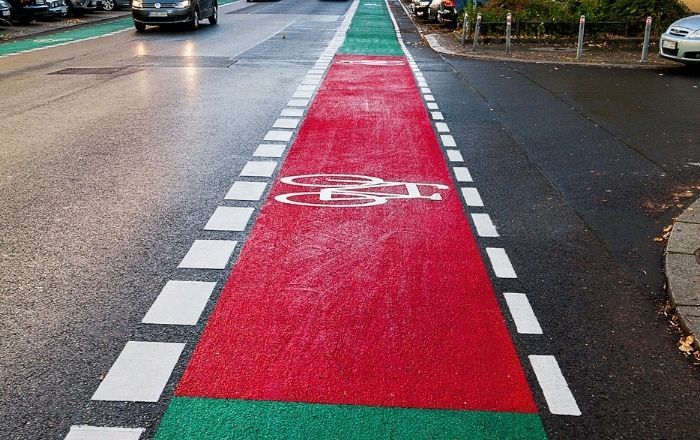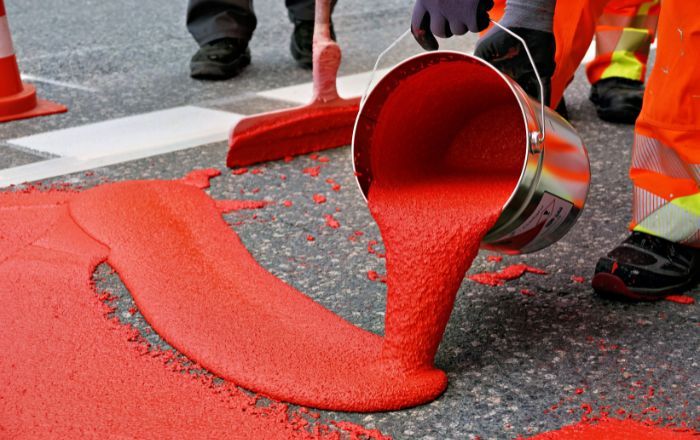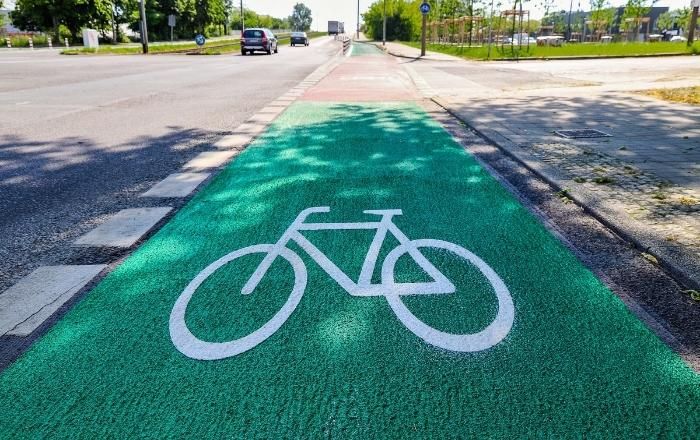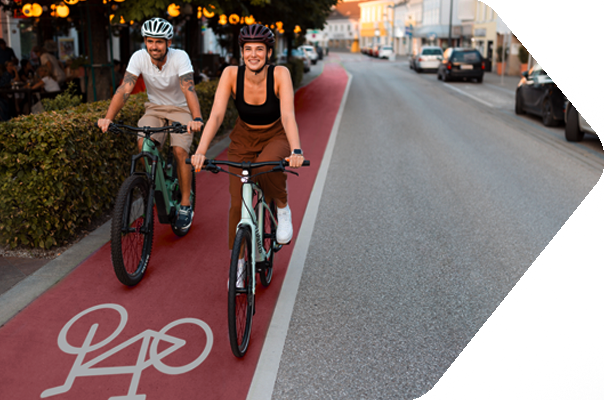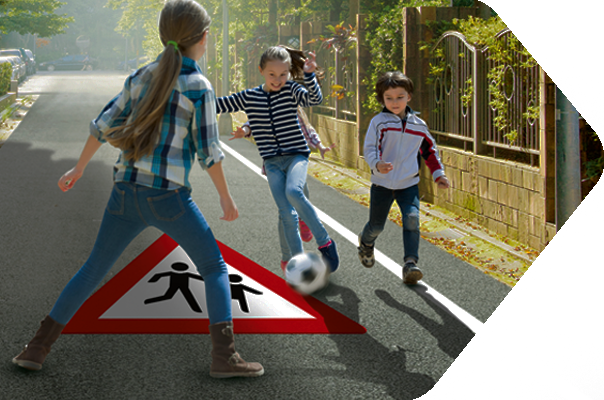Improving Bike Lane Visibility with Preformed Thermoplastics
Clearly visible messages for cyclists:
preformed thermoplastics used in modern transport infrastructure
Safe bike lanes start with choosing the right materials for the lane markings. Existing and new surface markings can be quickly and easily supplemented using preformed thermoplastics - for better visibility and enhanced safety for cyclists.
Cycling is becoming increasingly important. Cities and municipalities are investing in the expansion of safe, attractive and integrated cycling networks - whether to reduce motorised traffic, lower emissions or promote healthy mobility.
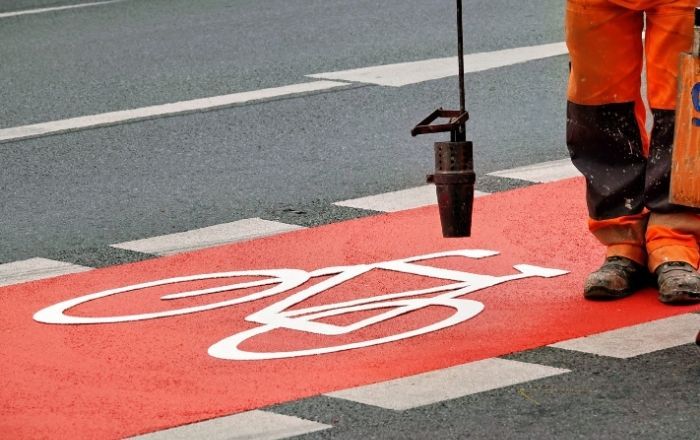
Making the right decisions when selecting marking material
Choosing the right marking materials is essential for safe and effective bike lane design. Clear lane markings guide traffic flow, define rights and responsibilities, and reduce confusion—especially for vulnerable road users like cyclists. Colour-coded separation between cycling and motorised traffic has proven highly effective, enhancing both structure and the sense of safety. While there are no binding colour standards, green is commonly used for bike lanes and red for intersections or hazard zones.

André Peiter
Sales, SWARCO Road Marking Systems
“When selecting the marking system, factors such as location, traffic volume, cost-effectiveness and environmental impact must also be taken into account. In urban areas, we recommend the use of special, almost solvent-free cold plastics for surface markings of bike lanes. Their rapid curing shortens road closures and helps minimise traffic disruptions.”
Two colour-coding systems providing multiple benefits
For the design of green and red cycle lanes, SWARCO Road Marking Systems recommends two particularly effective lane marking systems: SWARCOPLAST Roll RP 15 and SWARCOPLAST Tex. Both materials are characterised by their excellent slip resistance. This is achieved by using coarse-grained fillers in combination with the respective application technique. It is therefore not necessary to add additional grip agents. Both systems are also available as ECO versions with a binder that has a recycled share of more than 30 per cent. This means that environmentally sound solutions are available for modern biking facilities. As a result, CO2 emissions can be significantly reduced not only when biking, but also during road construction.
Coloured cold plastics form a solid basis for bike routes. Clear symbols, directional arrows and pictograms are essential for clear, intuitive traffic guidance. They ensure improved orientation and safety for cyclists. However, this is where traditional marking techniques reach their limits - especially when precision, design flexibility or fast processing on tight construction sites are required.
High precision symbols without additional effort with SWARCO PREFORMED
SWARCO PREFORMED offers a practical solution when traditional marking techniques reach their limits. As a ready-to-apply system, these prefabricated thermoplastic elements are the perfect complement to coloured area markings—combining design flexibility, high precision, and fast installation without the need for stencils or masking.

Laurens Meurer
SWARCO PREFORMED Product Expert
“The application is simple and time-saving. The elements – such as bicycle symbols and directional arrows – are cut to size at our factory and can be applied directly to existing surface markings. There is no need for time-consuming stencilling or masking work. This saves time and reduces traffic jams caused by longer road closures.”
Summary
The combination of SWARCO PREFORMED symbols with cold plastic area markings offers a thick-layered, particularly abrasion-resistant solution. For road operators, this means extended durability of the road markings and therefore noticeable economic benefits. Even more important, is the benefit for cyclists: the high skid resistance of both components provides reliable grip even in wet conditions. The clear, highly visible signage also offers safe and intuitive guidance - no matter where you are cycling to.
FAQs
Bike lane markings improve visibility and safety for cyclists, structure the traffic space, promote clear traffic guidance and reduce conflicts with other road users.
They visually separate cyclists from motorised traffic by using colour coding. Bike lanes and cycle paths provide clear structures, reduce uncertainty at junctions and intersections and improve cyclists' orientation through directional arrows. In addition, coloured bike lanes indicate that vehicles should not be parked in road areas intended for bicycle traffic. This reduces accidents and increases the feeling of safety among all road users.
There is no generally mandatory colour scheme for cycle paths - but there are recommendations (e.g. DSGS instructions for the marking of cycle traffic facilities in Germany or in the MUTCD in the USA). In practice, however, the colours green and red have proven to be effective. Both colours have a strong signalling effect, providing a clear distinction from motorised traffic. Green in various shades has established itself internationally as a preferred colour for cycle paths and is often chosen for continuous cycle routes in cities. Psychologically, green stands for nature, calm and serenity, while red signals danger. Red is therefore often used to indicate dangerous sections or intersections with motor vehicle traffic.
Yes, on request our materials can also be produced in other colours.
In most cases, either cold plastics or epoxy resin in combination with mineral silica sand are used to design the coloured surfaces. The benefits of cold plastics are the significantly shorter curing time and better suitability for lanes with higher traffic volumes. Two examples of such cold plastics are SWARCO Rollerplastic RP 15 and SWARCOPLAST Tex. These materials are also available within the SWARCO ECO-LINE containing recycled binder.
We are working to produce marking materials in the most environmentally friendly way possible, be it through energy-efficient production processes or the use of bio-based and recycled ingredients. Such marking systems are summarised under the SWARCO ECO-LINE product line. It includes materials for various areas of application - from water-based paints and cold spray plastics to preformed thermoplastics. It also includes materials for bike lane markings.
Yes, preformed thermoplastics are very easy to combine with surface markings made of cold plastics (e.g. textured and roller plastics). They can be applied to the surface marking with ease. Thanks to their high abrasion resistance, preformed thermoplastics are very durable.
Preformed thermoplastics are used on bike lanes to apply symbols, arrows and pictograms accurately, permanently and quickly. They increase the visibility of important signs and thus improve the safety of cyclists and other road users. Our preformed thermoplastics are grouped under the umbrella name SWARCO PREFORMED.
SWARCO PREFOMED elements are prefabricated in the production plant and are therefore ready for immediate use. This reduces preparation time, as no stencils or adhesive tape works are required. It saves time and minimises errors. Application is simple, clean and quick. In addition, the consistently high quality of the preferabricated symbols ensures a uniform, professional appearance. Further advantages include year-round usability, customisation options and suitability for various surfaces.
No, preformed thermoplastics are suitable for numerous other areas of application: on the road, on school paths, on car parks - but also on playgrounds or schoolyards.
First, the outline of the marking is drawn with chalk on the cleaned surface. If the surface is wet or cold, it must be dried and preheated. A primer is applied for better adhesion. The SWARCO PREFORMED marking is then applied and heated with a gas burner. Optionally, reflective glass beads and grip agents can be dropped-on afterwards. After successful adhesion testing, the marking is cleaned with a broom to remove any loose material.
To apply SWARCO PREFORMED, all you need is a regular gas burner, a broom, chalk and, if necessary, drop-on material. A primer can be used for enhanced adhesion to the surface.
On the coloured bike lanes, mainly white coloured preformed thermoplastics are used. However, SWARCO PREFORMED products are available in a wide range of colours - on request they can even be supplied in your favourite colour.
About SWARCO Road Marking Systems
Quality products and services from SWARCO Road Marking Systems guide traffic safely from A to B by day and, above all, by night. On all types of roads. Whatever the weather. From a single source. Over 5,000 customers in more than 80 countries place their trust in them.
